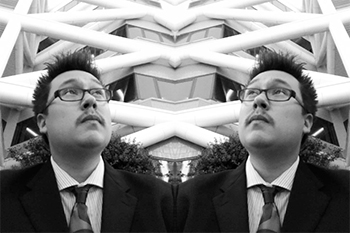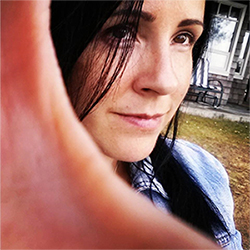Land Belonging to No One: Carleigh Baker in Conversation with Jordan Abel

Carleigh Baker, a writer who lives on the traditional, ancestral, unceded territory of the Musqueam, Squamish and Tsleil-Waututh peoples, interviews Nisga’a writer Jordan Abel about the intersection of poetry and academia in his poem, “Terra Nullius (3-5).”
Abel's poem appears in the Malahat’s Indigenous Perspectives Issue, dedicated entirely to contemporary Indigenous writing in Canada. Read his poem online here.
Your poem, “Terra Nullius (3-5),” can be loosely defined as “land belonging to no one,” or “land that is devoid of civilized society,” the latter definition being of particular relevance to Canadian settler colonialism. How are you working with this idea here?
The idea itself is something that I’ve been thinking about for a while now. My first substantial engagement with terra nullius was in my book-length work, Un/inhabited, which took a bit of a different approach than the piece that appears in The Malahat Review. My most recent interest in this concept actually comes from James Fenimore Cooper’s book, The Last of the Mohicans. At some point, I went on to Good Reads and started reading reviews of TLOTM. I was really interested in who was reading this book right now, and I stumbled on a group of Good Reads reviews from American high school students who all seemed to hate the book. But they seemed to hate it because it was boring, that Cooper spent an endless amount of time describing river valleys, rocks, and trees. So I began to wonder what was behind those description of land, landscape, and scenery. And also what happens when you just look at those blank descriptions.
There are powerful forces at work in “Terra Nullius (3-5)”! The erosive quality of rivers, the movement of water across the land. It reminded me of one of my favourite spots on Galiano Island, where the waves would crash against the pock-marked sandstone, and leave dozens of little pools when they retreated. Is this piece inspired by a particular location?
In a sense: yes. But that location is textual. The piece is derived entirely from descriptions of land from The Last of the Mohicans.
Your work in Injun was highly experimental, a deconstruction of the language of dime-novel westerns. The Place of Scraps was pretty experimental too, using erasure poetry to express ethnographic erasure. “Terra Nullius (3-5)” suggests a very different style—does this represent a progression in your writing, or perhaps a cycle back to an earlier style? Did something about your experiences writing Injun bring about this shift?
Writing, for me, is always a shifting/fluid/dynamic process. Even though I work primarily with found text, I am always trying to think through those primary texts in different ways. The piece “Terra Nullius (3-5)” is built out of sentences (and sentence fragments) that appear in TLOTM. For the most part, these sentence are unchanged. However, that project is ongoing. And in the subsequent stages of that project there are many moments where my own writing and Cooper’s writing becomes interweaved and indistinguishable. So there is definitely a shift. One that converges/collapses on the space of authorship.
You performed a soundscape from Injun for one of my Indigenous politics classes at UBC this fall, and we turned off the lights, which was certainly not a typical in-class experience. Do you feel that people experience poetry differently in the dark? Would you do the same kind of performance for a poem (or a collection of poetry) like “Terra Nullius (3-5)”?
Darkness, I think, is ideal for certain kinds of performances. As an author who is constantly challenging authorial spaces, the absence of light/spotlight in a performance shifts the way that the audience engages with/perceives the author. In a sense, darkness defuses the kind of power dynamics that take place in an author/audience relationship. So I would imagine that the experience of everyone in the room changes. In terms of performing that piece, I would say that I haven’t figured that out yet. For me, I often attempt to try out a few different performance approaches for each piece of writing before I figure it out. And even then I think you could argue that I have never quite figured out how to perform any one piece because my performances are constantly changing.
You’re currently working on a Ph.D at SFU. What are you studying? How do you feel your academic work informs and influences your poetry? What role does research play in your work? Does it get in the way of your creative brain sometimes?
The role that my academic research has played in my creative work has been almost 100% accidental so far. For example, I was recently doing the reading for my secondary comprehensive field exam (which was on formations of Indigenous identity) and I happened to read Roxanne Dunbar Ortiz’s book, An Indigenous Peoples’ History of the United States. That book ended up being a small part of my exam, but in there Ortiz makes an argument that Cooper’s novel TLOTM plays a role in reinventing the colonial origins of the United States, and in creating a narrative that was “instrumental in nullifying guilt related to genocide.” So I read TLOTM, and over the summer ended up an academic Digital Humanities conference in Victoria (DHSI). At that conference, I ended up enrolling in a topic modeling workshop and happened to use TLOTM as test corpus to topic model. As a result, I ended up noticing that several topics revolved around these blank descriptions of land. Which ultimately ended in engaging with TLOTM in more creative ways (including this piece). So I would say that there definitely intersections, and both creative and academic sides of my work end up informing/benefiting from each other.
Who are some of your academic and creative influences right now? 2016 was a pretty heavy year for many of us; do you feel like the current socio-political climate is having an influence on your reading?
In light of everything that happened in 2016, I have to admit that I am a huge fan of the #HonouringIndigenousWriters movement. In both my academic and creative work, I have tried to read as many Indigenous poets as I can, and I think there is some absolutely incredible work out there that honestly doesn’t get talked about enough. So, here’s a short, incomplete list of some Indigenous poets that everyone should be reading: Orlando White, Katherena Vermette, Gwen Benaway, Leanne Simpson, Marie Annharte Baker, Rosanna Deerchild, Jeanette Armstrong, Marvin Frances, Marilyn Dumont, Gregory Scofield, Armand Ruffo, Lisa Bird-Wilson, Louise Bernice Halfe, Sarain Stump, Leslie Silko, Janet Rogers, Kateri Akiwenzie-Damm, Chrystos, Diane Glancy, Joy Harjo, Lee Maracle, Liz Howard, Neal McLeod, Simon Ortiz, Dg Okpik, Philip Kevin Paul, Daniel David Moses, Layli Long Soldier, Wayne Keon, Rita Joe, Pauline Johnson, Joanne Arnott, Chris Bose, Louis Riel, Garry Gottfriedson, and Garry Thomas Morse. There are many more, too!

Carleigh Baker
* * * * * * * *









